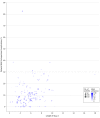Association Between Use of Enhanced Recovery After Surgery Protocol and Postoperative Complications in Total Hip and Knee Arthroplasty in the Postoperative Outcomes Within Enhanced Recovery After Surgery Protocol in Elective Total Hip and Knee Arthroplasty Study (POWER2)
- PMID: 32049352
- PMCID: PMC7042927
- DOI: 10.1001/jamasurg.2019.6024
Association Between Use of Enhanced Recovery After Surgery Protocol and Postoperative Complications in Total Hip and Knee Arthroplasty in the Postoperative Outcomes Within Enhanced Recovery After Surgery Protocol in Elective Total Hip and Knee Arthroplasty Study (POWER2)
Abstract
Importance: The Enhanced Recovery After Surgery (ERAS) care protocol has been shown to improve outcomes compared with traditional care in certain types of surgery.
Objective: To assess the association of use of the ERAS protocols with complications in patients undergoing elective total hip arthroplasty (THA) and total knee arthroplasty (TKA).
Design, setting, and participants: This multicenter, prospective cohort study included patients recruited from 131 centers in Spain from October 22 through December 22, 2018. All consecutive adults scheduled for elective THA or TKA were eligible for inclusion. Patients were stratified between those treated in a self-designated ERAS center (ERAS group) and those treated in a non-ERAS center (non-ERAS group). Data were analyzed from June 15 through September 15, 2019.
Exposures: Total hip or knee arthroplasty and perioperative management. Sixteen individual ERAS items were assessed in all included patients, whether they were treated at a center that was part of an established ERAS protocol or not.
Main outcomes and measures: The primary outcome was postoperative complications within 30 days after surgery. Secondary outcomes included length of stay and mortality.
Results: During the 2-month recruitment period, 6146 patients were included (3580 women [58.2%]; median age, 71 [interquartile range (IQR), 63-76] years). Of these, 680 patients (11.1%) presented with postoperative complications. No differences were found in the number of patients with overall postoperative complications between ERAS and non-ERAS groups (163 [10.2%] vs 517 [11.4%]; odds ratio [OR], 0.89; 95% CI, 0.74-1.07; P = .22). Fewer patients in the ERAS group had moderate to severe complications (73 [4.6%] vs 279 [6.1%]; OR, 0.74; 95% CI, 0.56-0.96; P = .02). The median overall adherence rate with the ERAS protocol was 50.0% (IQR, 43.8%-62.5%), with the rate for ERAS facilities being 68.8% (IQR, 56.2%-81.2%) vs 50.0% (IQR, 37.5%-56.2%) at non-ERAS centers (P < .001). Among the patients with the highest and lowest quartiles of adherence to ERAS components, the patients with the highest adherence had fewer overall postoperative complications (144 [10.6%] vs 270 [13.0%]; OR, 0.80; 95% CI, 0.64-0.99; P < .001) and moderate to severe postoperative complications (59 [4.4%] vs 143 [6.9%]; OR, 0.62; 95% CI, 0.45-0.84; P < .001) and shorter median length of hospital stay (4 [IQR, 3-5] vs 5 [IQR, 4-6] days; OR, 0.97; 95% CI, 0.96-0.99; P < .001).
Conclusions and relevance: An increase in adherence to the ERAS program was associated with a decrease in postoperative complications, although only a few ERAS items were individually associated with improved outcomes.
Conflict of interest statement
Figures




